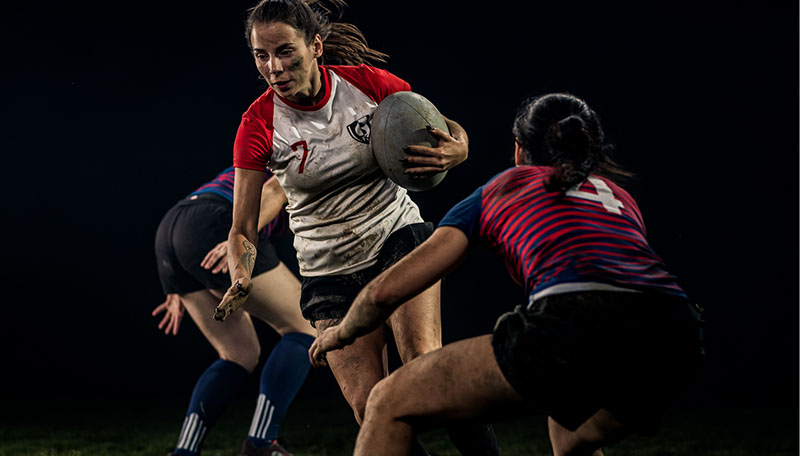The Women’s Rugby World Cup 2025, hosted in England, has reached its thrilling final phase with the semi-finals underway: New Zealand vs. Canada and France vs. England. The tournament, which began on August 22, 2025, has showcased exceptional athleticism and competitive spirit, drawing global attention to women’s rugby. What is the media and social media impact of the Women’s Rugby World Cup ?
Key Facts
- The Women’s Rugby World Cup 2025 has generated 326,000 social media mentions from 193,000 unique authors
- England leads team social media presence with 11.37% share of voice, followed by Canada (9.78%) and France (9.36%)
- South Africa’s Nadine Roos is the most mentioned player (5.18% share among top 100)
- Mastercard dominates sponsor conversations with 42.56% share of voice through its Player of the Match program
Table of Contents:
Social Media Buzz: Decoding the RWC 2025 Media Frenzy
Top Teams Dominating Social Media Since August 22
Star Players Stealing the Spotlight on Social Platforms
Sponsors Scoring Big: The Most Talked-About Brands of RWC 2025
I. Media Buzz: Decoding the RWC 2025 Media Frenzy
Analysis of social media flows and media coverage reveals exponential growth around the competition. The tournament has demonstrated significant traction in the digital sports ecosystem. The qualitative engagement observed on social media platforms reflects an organic amplification of content, particularly around dominant nations and exceptional individual performances.
Social media impact of the Women’s Rugby World Cup
From August 21 to September 14, 2025, the Women’s RWC 2025 has generated significant buzz online, amassing 326,000 mentions across social media platforms, according to the Onclusive Social Listening Tool. A total of 193,000 unique authors have contributed to the conversation, achieving a reach of 75 million. This reflects robust engagement and growing interest in women’s rugby.
For context, the Men’s Rugby World Cup 2023, over a similar timeframe, recorded 1.21 million mentions, with 590,000 authors and a reach of 97.6 million. While the men’s tournament garnered higher raw numbers, the Women’s RWC 2025 demonstrates a strong and vibrant social media presence, underscoring the rising popularity of the women’s game.
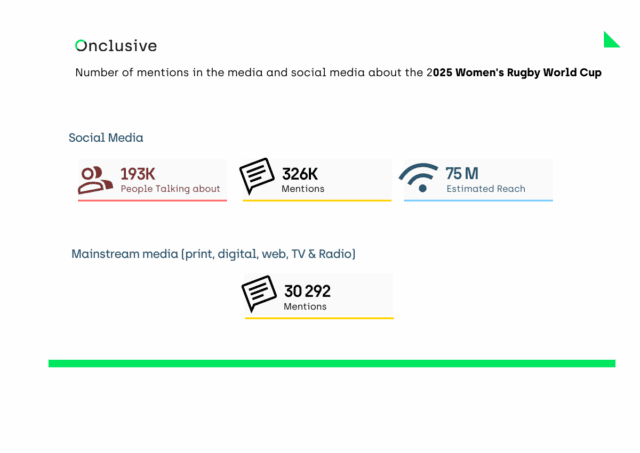
Number of mentions in the media and social media about the 2025 Women’s Rugby World Cup
Mainstream Media Coverage
The Women’s Rugby World Cup 2025 has also made a significant impact in mainstream media, including print, web, TV, and radio, with a total of 30,292 mentions. This extensive coverage highlights the tournament’s importance and its role in elevating the visibility of women’s rugby on a global stage.
II. Top Teams Dominating Social Media Since August 22
The provided data reflects the share of mentions across social platforms for the 16 participating teams during this window, with England leading at 11.37%, followed closely by Canada (9.78%), France (9.36%), and South Africa (8.27%). These figures capture a mix of fan discussions, match recaps, player highlights, and broader narratives around the tournament.
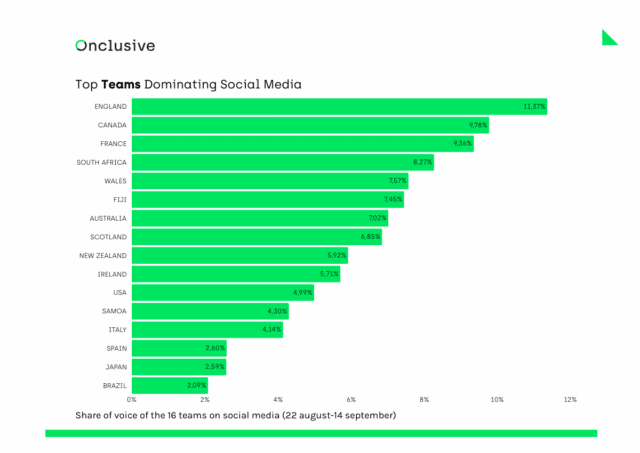
Share of voice of the 16 teams on social media (22 august-14 september) (via Onclusive Social Listening Tool)
#1 England: Home Advantage and Dominant Form
As the host nation and pre-tournament favorites (ranked No. 1 globally), England naturally drew the lion’s share of attention. Their unbeaten run through Pool A included massive victories like a 69-7 thrashing of the USA on opening day and a 47-7 win over Australia, setting up a quarterfinal against Scotland. These results fueled hype around their quest for a first World Cup title since 2014, with players like Emily Scarratt making history as the first England player to appear in five World Cups. Social chatter spiked around home crowds, royal patronage (e.g., the Princess of Wales attending the England-Australia match), and debates on their “juggernaut” status, including warnings about potential vulnerabilities as stakes rose. England’s media presence was amplified by local outlets, and their consistent excellence (e.g., Zoe Aldcroft’s return for the quarterfinal) kept them trending as the team to beat.
Overall, hosting duties and flawless execution made them a focal point for global fans and critics alike.
#2 Canada: Powerhouse Performances and Semifinal Push
Canada emerged as a major talking point with their unbeaten Pool B campaign and emphatic knockout entry. They started strong with a 65-7 rout of Fiji, followed by a 40-19 win over Scotland to top the group, and capped the period with a 46-5 quarterfinal demolition of Australia on September 13, booking a semifinal spot against New Zealand. Standout players like Julia Schell (six tries in the opener) and Emily Tuttosi (player of the match honors) generated viral highlights, while roster announcements and fan campaigns (e.g., fundraising for resources) added layers of discussion. Canada’s narrative as England’s biggest challengers—blending experience with emerging talent—resonated widely, especially in North America, where rugby’s growth amplified social shares. Their physical, high-scoring style contrasted with some upsets elsewhere, keeping them in conversations about who could dethrone the hosts.
#3 France: Clinical Wins and Tactical Buzz
France, another top-ranked side and 2021 semifinalist, maintained high visibility through their dominant Pool D run, culminating in a first-place finish and a quarterfinal win. They opened with a shutout 21-0 victory over Italy, then delivered a statement 57-10 win over South Africa, avoiding a tougher knockout path. On September 14, they edged Ireland 18-13 in a tense quarterfinal to advance to the semis, likely against England. Social media lit up with praise for their “iron defense” and dominant pack, including player spotlights like Pauline Bourdon Sansus and team compositions featuring stars like Joanna Grisez. France’s consistent excellence, combined with European rugby’s strong following, drove mentions—especially in French-language posts hyping their potential to upset bigger names. Their avoidance of New Zealand in the quarters added strategic intrigue, positioning them as a dark horse in broader tournament debates.
III. Star Players Stealing the Spotlight on Social Platforms
Another facet of the media impact of the Women’s Rugby World Cup is the coverage of the players.
The top 4 most mentioned players (totaling over 14% among the top 100) mirror their teams’ narratives: South Africa’s underdog breakthroughs (Roos and Hele fueling 17% of national pride posts), England’s home firepower (Breach’s milestones in a record win), and France’s clinical knockouts (Grisez’s drama). Viral tries, personal stories, and stats like line breaks/offloads drove shares, with X clips amplifying the buzz—e.g., Hele’s “beast” montages and Grisez’s sprint. As semis loom (England vs. France on Sept. 20), expect these stars to trend higher amid growing viewership.
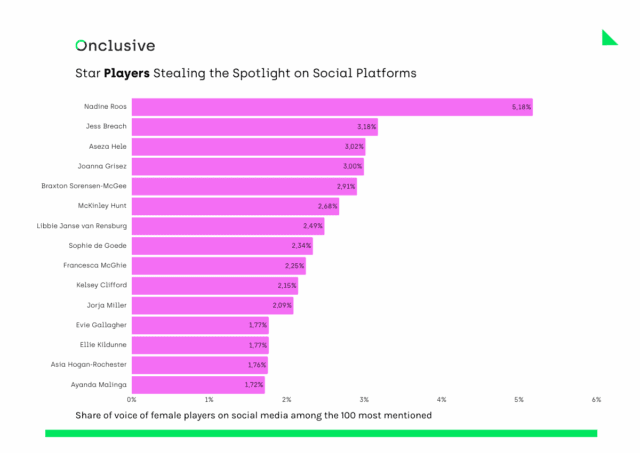
Share of voice of Rugby World Cup players on social media among the 100 most mentioned (via Onclusive Social Listening Tool)
Nadine Roos (South Africa, 5.18%):
Roos, a versatile Springboks back, topped mentions due to her try-scoring flair and positional flexibility (scrumhalf, flyhalf, wing, fullback) during South Africa’s historic quarterfinal run. Her standout moments included a crucial try against Italy and a 50-meter solo effort against France, with viral clips of her shimmies and leadership amplifying her “spirit warrior” story, boosted by South Africa’s passionate fanbase.
Jess Breach (England, 3.18%):
England’s wing Jess Breach dominated with a hat-trick in a 92-3 rout of Samoa, hitting her 50th try in her 49th cap. Her speed, seven line breaks, and milestone 50th cap against Australia fueled viral highlights, cementing her as a Red Roses star and a symbol of England’s home dominance.
Aseza Hele (South Africa, 3.02%):
Springboks No. 8 Aseza Hele’s “beast mode” carries, including a hat-trick against Brazil and a try against Italy, powered South Africa’s breakout campaign. Her 161 meters carried, offloads, and off-field warmth (e.g., gifting her jersey) sparked global buzz, with clips of her physicality driving mentions.
Joanna Grisez (France, 3%):
France’s winger Joanna Grisez shone with two tries against South Africa and a game-changing 60-meter intercept try to upset Ireland in the quarterfinals. Her clutch performance, post-Olympics recovery, and sevens pedigree made her a viral hero, boosting France’s semi-final hype.
IV. Sponsors Scoring Big: The Most Talked-About Brands of RWC 2025
These sponsors’ mention shares (totaling ~75%) reflect RWC 2025’s blend of global visibility and targeted narratives, with Mastercard’s per-match integrations dominating amid 275,000+ tickets sold and record viewership. Principal partners like Mastercard and Gallagher led due to direct tournament ties, while O2 benefited from England hosting hype. Asahi and Allianz rounded out with regional and supportive angles, aligning with World Rugby’s push for women’s growth—expect semis (e.g., England vs. France on Sept. 20) to shift dynamics further.
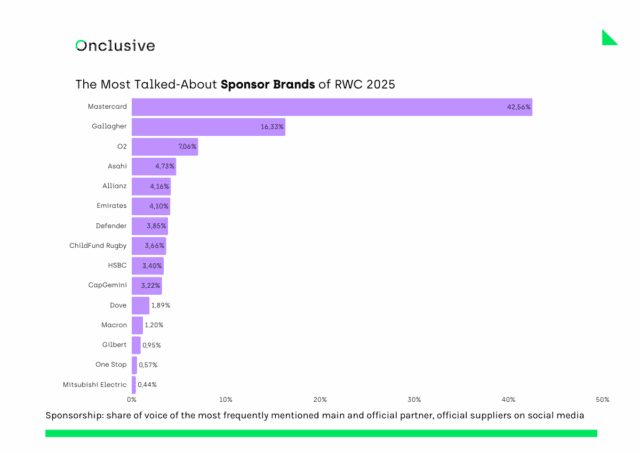
Sponsorship: share of voice of the most frequently mentioned main and official partner, official supplier (via Onclusive Social Listening Tool)
Mastercard: Principal Partner and Player of the Match Spotlight (42.56%)
As the principal partner of the Women’s Rugby World Cup 2025, Mastercard’s dominant social media presence stems from its high-visibility “Priceless” sponsorship activations, particularly the Player of the Match (POTM) award program. Every match since the August 22 opener has featured official announcements tagging Mastercard alongside standout performers—like England’s Ellie Kildunne in the 81-0 USA rout, South Africa’s Aphiwe Ngwevu in the Brazil win, and Canada’s Sophie de Goede in the quarterfinal vs. Australia—generating consistent, shareable content across 20+ pool and knockout games.
This daily integration with viral highlights, combined with Mastercard’s global “Priceless” campaign tying into fan experiences and ticket perks, created a feedback loop of engagement, far outpacing other sponsors in volume and recency.
Gallagher: High-Performance Academy and Women’s Development Focus (16.33%)
Gallagher, an official insurance partner of women’s rugby and the tournament, earned its strong mentions through its founding role in the Gallagher High Performance Academy, a global program accelerating female coaches and elite roles ahead of RWC 2025. Social buzz peaked around academy announcements, talent spotlights, and tie-ins to the tournament’s growth narrative, such as posts celebrating emerging coaches during pool stages and linking to World Rugby’s diversity push. As a multi-year backer with rugby roots in key markets like England and New Zealand, Gallagher’s content emphasized inspirational stories—e.g., pathways for the next generation—resonating in development-focused discussions, especially amid the event’s record attendance and women’s game expansion.
O2: Official England Telecom and Home Nation Hype (7.06%)
O2, the official connectivity partner for England Rugby and a key RWC 2025 backer, surged in mentions via its “Wear the Rose” campaign amplifying the host nation’s unbeaten run, including the Princess of Wales’s attendance at the England-Australia match. Posts from O2’s channels featured exclusive content like interviews with Red Roses legends (e.g., Maggie Alphonsi) and Fin Smith, plus live streaming tie-ins for quarterfinals, driving UK-centric engagement around home victories like the 47-7 Australia win. This localized focus on England’s “juggernaut” status and fan experiences, bolstered by O2’s long-term rugby investments, positioned it as a symbol of national pride during the tournament’s high-stakes phase.
Asahi: Official Beer and Asia-Pacific Activation (4.73%)
Asahi Super Dry, the official beer sponsor for RWC 2025, saw mentions tied to its Asia-Pacific market push, including activations around Japan’s Brave Blossoms matches (e.g., vs. Spain and Ireland) and broader tournament hospitality like branded fan zones. Social chatter included ambassador posts from Japanese rugby figures and celebrations of scoring plays, amplified by Asahi’s integration into Pacific Nations Cup tie-ins running parallel to the World Cup. With a focus on refreshing match-day vibes and cultural nods (e.g., Japanese royal attendance at Sakura games), Asahi’s content appealed to emerging markets, generating steady but targeted buzz amid the event’s global reach.
Allianz: Insurance Partner and Risk Management Narrative (4.16%)
Allianz, as an official insurance and risk management partner, garnered mentions through its emphasis on player welfare, event security, and sustainability efforts during the tournament’s expansion to 16 teams. Key drivers included posts on injury prevention programs, safe fan experiences at sold-out venues, and tie-ins to Allianz’s global rugby portfolio (e.g., supporting WXV qualifiers). Amid dramatic knockouts like France’s comeback vs. Ireland, discussions on the “risks and rewards” of women’s rugby growth highlighted Allianz’s role, with corporate and fan content underscoring its commitment to a safer, more inclusive game—though lower volume reflects its more behind-the-scenes positioning compared to flashier activations.
All these metrics and data are valuable indicators for sports marketing professionals seeking to optimise their engagement strategy in an ever-changing media environment. The exponential growth in the visibility of women’s rugby now provides a framework for analysing the maturation of women’s sports in the global digital ecosystem.
Ready to take your social media strategy to the next level? Don’t wait to enhance and support your Social Listening analyses with artificial intelligence-powered functions.

